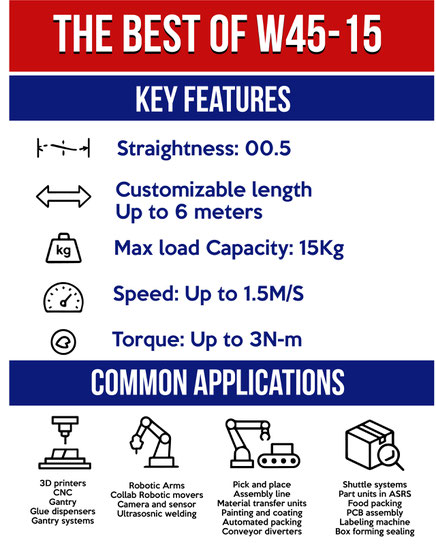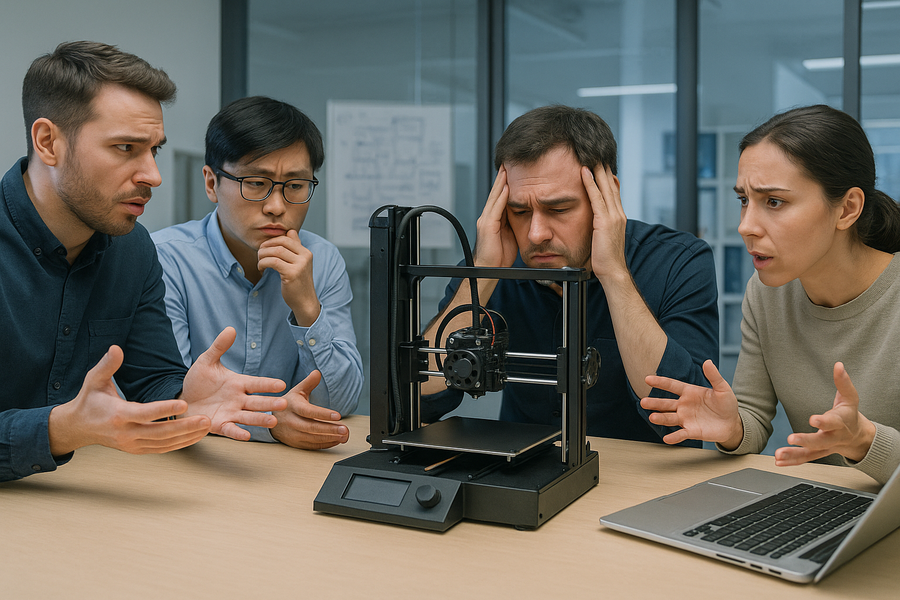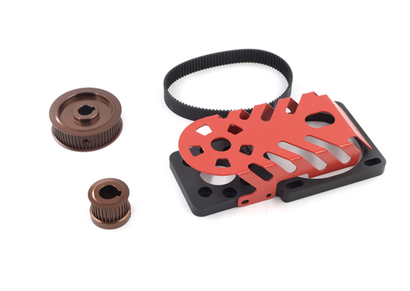CCM W45-15 linear guide rails belt driven for 3D printers

Looking for the Right Linear Guide Rail for Your Application?
We understand how overwhelming it can be to choose the right linear guide rail when so many options online look similar and claim high performance. That’s why we’ve made it simple for you.
You have two clear options:
1. Stay here and check the technical specifications of our precision-engineered linear guide rail modules.
or check
2. How to Choose the Right Belt-Driven Linear Rail—Without Wasting Time or Money. Avoid common pitfalls, decode tech specs, and find the rail that fits your application perfectly.
Technical Parameters W45-15
-
Guide Width: 45 mm
-
Max Load: 15 kg
-
Pitch: 80 mm
-
Synchronous Wheel Spec: STD5M-16Z
-
Recommended Speed: ≤ 1.5 m/s
-
Customized Length: Up to 6 meters
-
Input Torque: ≤ 3 N·m
-
Belt Spec: PU-5M-15 (steel wire)
-
Straightness: 0.05 / 300 mm
-
Applicable Motors:
-
Stepper Motor: Nema 17 (Direct Connection)
-
Servo Motor: 100W (Direct Connection); 200W/400W (DC/Speed Reducer Set)
-
-
Suggested Length Adjustment: Effective stroke + 250 mm, with increments of 50 mm (e.g., 1000 mm, 1050 mm, 1100 mm)
This encapsulates the main technical details for the W45-15 linear motion module . If you require the full data sheet of the technical parameters, please contact us.

Features
-
High Precision – Engineered for accurate, repeatable motion in demanding applications.
-
Custom Lengths (up to 4 meters) – Tailored to fit your exact design and space requirements.
-
Corrosion-Resistant – Built with materials that withstand harsh environments and extend service life.
-
Maintenance-Free Operation – Designed for long-term use without regular servicing.
-
Ultra-Quiet Performance – Operates smoothly with minimal noise, ideal for sensitive settings.
-
Low Vibration – Ensures stable, consistent movement even at high speeds.
-
Trusted Reliability – Proven performance with minimal downtime across industries.
-
Long-Lasting Durability – Withstands continuous use under heavy loads and extended cycles.
-
Modular & Expandable – Easily integrates with accessories, sensors, and multi-axis systems.
Applications
-
Robotic Arms – Enables precise, repeatable linear motion for multi-axis automation.
-
3D Printers – Supports smooth, high-speed movement for accurate layer deposition.
-
CNC Router Machines – Ensures stable, rigid travel for cutting, milling, and shaping tasks.
-
Pick-and-Place Systems – Delivers fast, accurate positioning for high-throughput assembly lines.
-
Adhesive Dispensing Systems – Maintains controlled motion for uniform glue application.
-
Automated Painting Machines – Provides smooth, vibration-free movement for even coatings.
-
Packaging Equipment – Supports efficient and synchronized operations in automated packing lines.
-
Industrial Coding & Labeling Machines – Enables precise product marking and serialization.
-
Gantry Robots – Ideal for large-area, multi-axis systems requiring synchronized linear travel.
How to order
-
Tell Us About Your Project
Share your application details, goals, or challenges—our team is here to help. -
Provide Key Specs
Let us know the load weight, stroke length for each axis, travel speed, structure type, or environmental requirements. -
Receive a Tailored Quote
We’ll assess your needs and send you a detailed cost estimate—fast and accurate. -
Confirm & Start Production
Once payment is received, we’ll move your order into production with precision and care. -
We Handle the Shipping
We arrange safe and efficient delivery to your door, anywhere in the world.
-
Share Your Feedback
Your input matters—let us know how we did so we can keep improving.
Top 5 Mistakes to Avoid When Building Your Own 3D Printer

(Plus Tips That’ll Save You Time, Money, and Headaches)
Building a custom 3D printer is a fun and rewarding project—but if you skip the details or take shortcuts, it can turn into a frustrating mess real fast. We’ve helped a lot of people build printers that actually work, and here are the top 5 mistakes we’ve seen (and how to avoid them):
1. Skipping on Motion Quality: Don’t Cheap Out on Linear Rails & Actuators
If your motion system isn’t rock solid, your prints won’t be either. Wobble, backlash, or uneven motion can ruin even the best slicer settings. One of the most common mistakes? Using low-grade linear rods or wobbly guide systems.
Pro Tip: Go with belt-driven linear guide rails for smoother, faster, and quieter movement—especially for the X and Y axes. They’re perfect for high-speed printing without losing accuracy.
2. Poor Frame Alignment or Rigidity
Your frame is the backbone of your printer. If it flexes, twists, or isn’t square, your print quality will suffer—no matter how good the electronics or firmware are.
Pro Tip: Use aluminum extrusion or rigid metal frames. Always measure diagonals to ensure squareness, and take your time aligning the motion system. Precision here saves hours of troubleshooting later.
3. Underestimating Thermal Management
Hotends, heated beds, and stepper drivers generate a lot of heat. If you don’t plan for proper cooling, expect thermal throttling, layer shifts, or even shutdowns.
Pro Tip: Actively cool stepper drivers and electronics, and make sure your hotend cooling fan is properly aimed. Also, don’t skimp on a good quality power supply—it affects thermal stability more than you’d think.
4. Ignoring Cable Management and EMI
Loose cables, bad grounding, or cheap wires can cause electrical interference (EMI), random errors, or even short circuits. It’s not the fun part, but it’s essential.
Pro Tip: Use shielded cables where needed (especially around stepper motors), keep power and data wires separate, and always secure cables to avoid strain or snagging. Tidy wiring = reliable prints.
5. Not Planning for Maintenance or Accessibility
It’s tempting to cram everything into a compact frame—but if you can’t reach your stepper driver, nozzle, or belts easily, even a small repair becomes a big job.
Pro Tip: Build with access in mind. Use modular parts where possible, and make sure your motion components (like belts or linear actuators) are easy to tension or replace. You'll thank yourself later.
Finally, from our experience suppling uncountable 3D printer projects:
We’ve seen some amazing printers come together—and we’ve also helped fix plenty that went sideways. If you take care of motion quality (especially with belt-driven linear actuators), frame stability, and clean electronics, you're 80% of the way there.
And hey—if you ever need help choosing the right linear rails, belts, or actuator kits for your build, we’re just a message away. We’re here to help.
Other Options
Accesories for linear guide rails


